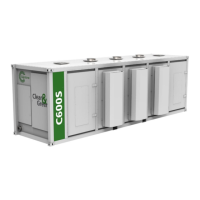Capstone Turbine Corporation • 16640 Stagg Street • Van Nuys • CA 91406 • USA
Installation Guide: Capstone C1000S/C800S/C600S with C1000 Series Controller
480064 Rev C (December 2018) Page 64 of 122
Capstone reserves the right to change or modify, without notice, the design, specifications, and/or contents of this document without
incurring any obligation either with respect to equipment previously sold or in the process of construction.
Fuel system must be designed to handle at least 1.5x the maximum load fuel flow, due to
the fuel requirement for cold startups. This is an important consideration when selectin the
diameter of system piping and components.
Drip traps should be installed at any point in the line of pipe where condensation may
occur. Drip traps must be easy to access and clean.
Fuel lines should be sloped in such a manner as to direct any condensate into a separation
vessel, drip leg, or serviceable area. If piping is installed underground, special
consideration must be taken for collecting condensate and removing it. This may involve
a sump tank and pump.
Fuel lines should be painted in order to protect the pipe from corrosion and, as a safety
feature, to discern fuel lines from other piping. Local code may determine, but a common
fuel system color is yellow.
6.5.8. Materials Selection
In many cases coated carbon steel material can be used, but material selection will depend on
the composition of the fuel being used. This applies to piping as well as other components such
as regulators, compressors, valves, and vessels, as all these components are exposed to the
fuel.
Sour gas containing H
2
S is corrosive, and liquid condensate may contain corrosive contaminants.
Stainless steel, plastic, and aluminum are the preferred materials of construction for corrosive
compounds. Brass and copper should not be used, and carbon steel will also eventually corrode;
leaving byproducts that can clog and damage other equipment.
Plastic pipe is used in some locations but is not permitted in others. This type of pipe has the
advantage of being corrosion-proof, but can be more-easily damaged by accident or by frozen
water expansion during winter.
6.5.9. Instrumentation and Controls
Capstone recommends that temperature and pressure indicators be installed in order to better
monitor and troubleshoot the system. Pressure and temperature transmitters, and other system
controls can be added in order to add safety and response to the system. Some general controls
examples are listed below, more detailed controls will be based on the specific components
installed in the fuel system.
High and low pressure alarms
High and low temperature alarms
Vapor-liquid separator and drip leg high level alarms
Filter high pressure drop alarms
Fuel tank level alarms.

